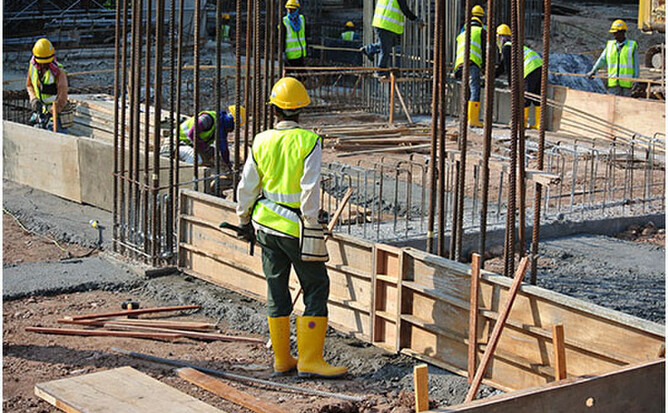Shoppers expect a retail space to feel inviting, functional, and easy to navigate. A retail building serves as the physical environment where businesses sell goods and services to customers. Storefronts, shopping centers, and standalone stores fall under this category, each designed to meet specific business needs. Every detail, from layout to materials, plays a role in customer flow and brand image. Poorly designed spaces can discourage visitors, while well-planned structures enhance shopping experiences and boost sales.
Construction decisions impact long-term business success. Owners and developers must consider zoning laws, permits, materials, and costs to avoid project delays and compliance issues. Careful site selection ensures visibility and accessibility, directly influencing customer traffic. Here is how each factor shapes a successful retail build.
Building Design Impacts Customer Experience
Layout, lighting, and accessibility shape how customers interact with a store. A cramped or poorly lit space can make shopping feel frustrating, leading to shorter visits and lower sales. Open, well-organized layouts encourage browsing and increase the likelihood of purchases. Entrances should be welcoming, and aisles must accommodate comfortable movement for all customers, including those with mobility challenges.
Architectural style and finishes also affect perception. A modern design may attract high-end shoppers, while a rustic theme can create a cozy atmosphere. Flooring, shelving, and checkout placement influence how customers navigate the space. Proper ventilation and temperature control keep visitors comfortable, making them more likely to stay longer. Every design choice impacts how people interact with a retail build, shaping the overall shopping experience.
Zoning Laws Shape Construction Requirements
Local regulations dictate where a retail build can be constructed and what features it must include. Zoning laws specify approved property uses, ensuring commercial developments fit within designated areas. Some locations allow mixed-use buildings, while others limit commercial activity to specific districts. Developers must confirm compliance before purchasing land to avoid costly adjustments or project cancellations.
Building codes set requirements for parking, signage, and accessibility. Some areas enforce strict design guidelines, affecting store appearance and signage size. Fire safety measures, such as sprinkler systems and emergency exits, must meet local standards. Non-compliance can result in fines or legal challenges. Consulting with zoning officials before planning a store build helps prevent delays and unexpected costs.
Permitting Processes Vary by Location
Every retail build requires approval before construction begins. Local governments issue permits to confirm projects meet safety and environmental regulations. Applications often include architectural plans, structural details, and environmental impact assessments. Some cities have fast-track options for small projects, while larger developments undergo detailed reviews, leading to longer wait times.
Inspections occur at various stages to confirm compliance with approved plans. Electrical, plumbing, and HVAC systems must pass safety checks before the building opens to the public. Skipping permits can lead to work stoppages or fines. Hiring experienced contractors familiar with local regulations reduces approval delays and ensures smooth project progression.
Construction Materials Affect Building Longevity
Material selection impacts durability, maintenance, and energy efficiency in a retail build. High-traffic areas require durable flooring that withstands wear and tear. Tile, polished concrete, and commercial-grade vinyl last longer than standard materials. Exterior finishes, such as brick or metal panels, provide weather resistance and enhance curb appeal.
Insulation and window quality affect heating and cooling costs. Poor insulation leads to higher energy bills, while energy-efficient glass reduces heat loss and glare. Fire-resistant materials increase safety, protecting the building and customers. Choosing quality materials reduces long-term repair expenses and maintains property value.
Budgeting Controls Project Feasibility
A retail build depends on careful financial planning to stay within budget. Costs include land acquisition, design fees, labor, and materials. Unexpected expenses, such as permit fees or supply chain delays, can increase overall spending. Setting a contingency fund prevents financial strain if costs rise during construction.
Value engineering helps balance affordability with quality. Adjusting material choices or simplifying design features can reduce expenses without sacrificing functionality. Comparing contractor bids ensures competitive pricing and prevents overpaying for labor. Detailed cost breakdowns keep expenses under control and improve financial planning for the project.
Timelines Depend on Project Complexity
Construction schedules vary based on project scope. A small store build may take a few months, while large-scale retail centers require over a year to complete. Factors such as site preparation, weather conditions, and labor availability impact timelines. Delays in permits or material shipments can extend completion dates.
Pre-construction planning helps avoid schedule disruptions. Securing permits early and ordering materials in advance prevents last-minute obstacles. A well-coordinated team ensures tasks progress efficiently, keeping the project on track. Clear communication between developers, contractors, and suppliers minimizes downtime and ensures timely completion.
Site Selection Determines Business Success
Choosing the right location affects customer traffic and long-term profitability. High-visibility areas with strong foot traffic attract more visitors, increasing sales potential. Proximity to public transportation and parking availability influence convenience for shoppers. A retail build in a poorly accessible area may struggle to attract customers, even with a strong brand presence.
Demographic research helps match store offerings to local demand. Areas with high disposable income support premium retail, while budget-friendly options thrive in price-sensitive communities. Competitor presence can indicate market demand but may also create saturation risks. Selecting a well-positioned site maximizes business potential and supports long-term growth.
Get Expert Guidance on Your Retail Construction Project
A well-planned retail build improves customer experience and business success. Every decision, from zoning approvals to material selection, impacts project outcome. Working with experienced professionals ensures compliance with regulations, efficient construction timelines, and cost-effective solutions. Call or text us today to discuss your retail construction needs.
Energy Efficiency Reduces Operating Costs
Energy use in a retail build affects long-term expenses. Poor insulation, outdated HVAC systems, and inefficient lighting increase utility bills. Smart design choices help control costs while maintaining a comfortable shopping environment. High-performance windows reduce heat loss, and LED lighting lowers electricity consumption. Automated climate controls adjust heating and cooling based on occupancy, preventing wasted energy. These upgrades decrease operational expenses and improve overall sustainability.
Solar panels and energy-efficient roofing materials offer additional cost savings. Some locations offer incentives for eco-friendly building improvements, reducing upfront costs. Using sustainable materials benefits the environment and enhances brand reputation. A well-planned energy strategy in a store build minimizes waste, lowers expenses, and creates a more sustainable business model.
Accessibility Standards Must Be Followed
Retail spaces must accommodate all customers. Regulations require buildings to meet accessibility standards for mobility, vision, and hearing needs. Entrances must include ramps or automatic doors, and aisles must be wide enough for wheelchairs. Checkout counters should provide accessible service points, ensuring all customers can complete purchases comfortably. Ignoring these standards can result in fines or legal action.
Restrooms, signage, and parking also follow strict requirements. Clear wayfinding signs help visually impaired customers, while audio assistance improves navigation for those with hearing impairments. Well-designed parking lots include designated accessible spaces near entrances. Every aspect of a retail build must support inclusivity, creating a space where all customers can shop with ease.
Tenant Needs Influence Interior Layouts
Leasing space in a store requires flexibility in design. Different retailers have specific layout requirements based on their products and customer flow. Clothing stores prioritize fitting rooms and display racks, while grocery stores need refrigeration units and wide aisles. Planning for adaptable spaces allows businesses to modify layouts without major structural changes.
Power and plumbing placement impact tenant operations. Restaurants need commercial kitchen setups, while electronic retailers require numerous power outlets. Landlords who design flexible spaces attract a wider range of tenants, increasing lease potential. A well-thought-out retail build accommodates various business needs, ensuring long-term usability and profitability.
Safety Regulations Guide Structural Choices
Building safety affects customers and employees. Fire-resistant materials, emergency exits, and proper ventilation reduce hazards. Local codes require smoke alarms, sprinkler systems, and accessible evacuation routes. Failure to meet these standards can lead to costly fines or closures. Every element of a retail build must prioritize safety to protect occupants.
Structural integrity prevents long-term risks. Reinforced walls, impact-resistant glass, and seismic-resistant foundations improve building durability. Security measures, such as surveillance cameras and reinforced entry points, enhance overall safety. A well-constructed store meets all regulations while ensuring a secure environment for shoppers and staff.
Technology Integration Enhances Operations
Modern retail spaces rely on technology for efficiency. Smart lighting systems adjust brightness based on foot traffic, reducing energy costs. Security cameras monitor activity, preventing theft and enhancing customer safety. High-speed internet supports digital payment systems, online ordering, and interactive shopping experiences. Investing in technology improves business operations and customer satisfaction.
Automated inventory tracking prevents stock shortages. Smart shelves notify staff when products run low, ensuring quick restocking. Self-checkout stations and mobile payment options streamline transactions, reducing wait times. Businesses that prioritize tech-driven solutions in a retail build enhance efficiency, improve security, and stay competitive in an evolving market.
Parking and Traffic Flow Matter Greatly
Retail success depends on accessibility. A poorly planned parking lot discourages customers, leading to lost sales. Well-marked entry and exit points, clear signage, and designated pedestrian walkways improve traffic flow. Properly placed speed bumps and lighting enhance safety for drivers and pedestrians. A well-organized retail build ensures customers can navigate the property without frustration.
Parking availability influences business performance. Insufficient spaces force customers to park elsewhere, while overcrowded lots create congestion. Planning for the right number of spots prevents bottlenecks and enhances the visitor experience. Locations near public transit or shared parking areas increase accessibility, making businesses more attractive to shoppers.
Renovations Require Different Planning Steps
Updating an existing store build follows different processes than new construction. Structural assessments determine what can be modified without compromising safety. Older buildings may require electrical and plumbing upgrades to meet modern standards. Permits must be obtained before making significant changes to layout, signage, or accessibility features.
Minimizing downtime is key. Phased renovations allow stores to operate while improvements occur, reducing revenue loss. Planning around peak business hours ensures minimal disruption to customers. A well-executed renovation enhances appearance, improves functionality, and increases property value without major business interruptions.
Commercial Builders in NYC – PE Builders Helps With Retail Construction Planning
Building a successful retail space requires careful planning and expert execution. A well-structured retail construction planning process considers zoning, safety, energy efficiency, and customer experience. Every detail, from permitting to materials, influences business success. A poorly designed layout limits customer traffic, while a thoughtfully constructed store build encourages engagement and increases sales potential.
PE Builders specializes in constructing high-quality retail spaces that align with business goals. Our team of commercial builders in NYC works closely with clients to ensure every retail construction planning decision meets both regulatory and operational needs. We handle everything from site selection to final finishes, delivering spaces that attract customers and enhance business performance. Contact us today to discuss your retail construction project with PE Builders.

